Annual Report of the Origin of Natural Gas Liquids Production
Oil and Gas Reserves System Surveys
201X EIA-64A Instructions
Annual Report of the Origin of Natural Gas Liquids Production
OMB: 1905-0057
|
U.S. DEPARTMENT OF ENERGY Energy Information Administration Washington, DC 20585 |
Form Approved OMB Number: 1905-0057 Expiration
Date: xx/xx/xxxx |
ANNUAL REPORT OF THE ORIGIN OF NATURAL GAS LIQUIDS PRODUCTION
FORM EIA-64A
GENERAL INSTRUCTIONS
The collection of basic, verifiable information on the Nation's reserves and production of natural gas liquids (NGL) is mandated by the Federal Energy Administration Act of 1974 (FEAA) (Public Law 93-275) and the Department of Energy (DOE) Organization Act of 1977 (Public Law 95-91). The data collected on the Energy Information Administration (EIA) Form EIA-64A includes the annual volumes of natural gas received, and natural gas liquids extracted at gas processing plants by areas of origin. It also includes the total gas shrinkage resulting from the natural gas liquids extracted and the annual volume of natural gas utilized as fuel at the gas processing plants.
Gas shrinkage volumes reported by natural gas processing plant operators on Form EIA-64A are used with natural gas data collected on a "wet after lease separation" basis on Form EIA-23, Annual Survey of Domestic Oil and Gas Reserves, to estimate "dry" natural gas reserves and production volumes regionally and nationally. The shrinkage data are also used, along with the plant liquids production data reported on Form EIA-64A and lease condensate data reported on Form EIA-23, to estimate regional and national gas liquids reserves and production volumes. This information is the only comprehensive source of credible natural gas liquids data and is required by DOE to assist in the formulation of national energy policies.
The information collected on Form EIA-64A will be used:
as key input to the EIA publication entitled U.S. Crude Oil, Natural Gas and Natural Gas Liquids Reserves;
to estimate extraction loss volumes contained in the EIA publication Natural Gas Annual
as the replacement for the natural gas liquids data which were published in the past by the American Petroleum Institute (API) and the American Gas Association (AGA) in their annual statistical reports entitled, Reserves of Crude Oil, Natural Gas Liquids, and Natural Gas in the United States.
WHO MUST SUBMIT
Each
operator of one or more domestic natural gas processing plants is
required to file a Form EIA-64A for each plant operated as of
December 31, 201X. If a plant was
operated during any part of survey year 201X, a Form EIA-64A must be submitted for that plant. In cases in which two or more operators during the survey year operated a plant, the operator as of December 31, 201X should file a Form EIA-64A that covers the entire survey year.
If the current operator is unable to obtain from previous operators the information required to compile accurate data covering the entire survey year, then each operator should file a Form EIA-64A covering only that portion of the survey year during which he operated the plant.
If there is some question whether a plant is a "natural gas processing plant" or "field separation facility," contact your company's responsible preparer of Form EIA-23, Annual Survey of Domestic Oil and Gas Reserves, in order to internally coordinate your responses. This will ensure that double reporting or non-reporting of natural gas liquids data does not occur.
WHAT MUST BE SUBMITTED
Each operator is required to complete a separate Form EIA-64A for each gas processing plant. If you had a plant in operation as of December 31, 201X and did not receive a Form EIA-64A for it, a completed form should still be filed for that plant. Respondents need submit only one copy of the completed form for each plant. Form EIA-64A solicits annual data separated by area of origin not required on Form EIA-816, Monthly Natural Gas Liquids Report. Form EIA-64A does not replace or supersede Form EIA-816 that is still required on a monthly basis.
WHEN AND WHERE TO SUBMIT
Form EIA-64A must be completed and submitted to EIA on or before April 17, 201Y for the 201X calendar year.
To facilitate the processing of data, the use of EIA forms is requested (either hardcopies or Excel spreadsheets). Additional copies of the EIA-64A form and instructions are available in PDF or XLS format on the EIA website http://www.eia.doe.gov/oss/forms.html#eia-64a. Computer printouts on other than an exact duplicate of the form provided are not acceptable. Photocopies of the form may be used.
Completed forms may be submitted by Secure File Transfer, email, fax, or mail.
Secure File Transfer: Instructions are on page 4
Email completed forms to: [email protected]
Fax completed forms to: 202-586-1076
Mail completed forms to:
Oil and Gas Surveys
U. S. Department of Energy, EIA
Ben Franklin Station
P O Box 279
Washington DC 20044-0279
Electronic filing (by Secure File Transfer, email or fax) is encouraged. When using the Excel spreadsheet, it is recommended you save the original form on your hard drive and then use it to make additional copies. When entering responses on hard copies, type or print in black ink using all capital letters.
If you need assistance filing your data or an extension of time to file, contact the EIA-64A Coordinator 1-800-879-1470 from 8:00 a.m. to 4:30 p.m. Central Time.
RECORD KEEPING REQUIREMENTS
You are required to keep all records necessary to reconstruct the data reported on this form for a period of three (3) years.
SANCTIONS
The timely submission of Form EIA-64A by those required to report is mandatory under Section 13 (b) of the Energy Information Administration Act of 1974 (FEAA) (Public Law 93-275), as amended. Failure to respond may result in a civil penalty of not more than $2,750 a day for each violation or a fine of not more than $5,000 a day for each willful violation. The government may bring a civil action to prohibit reporting violations that may result in a temporary restraining order or a preliminary or permanent injunction without bond. In such civil action, the court may also issue mandatory injunctions commanding any person to comply with these reporting requirements.
DISCLOSURE OF INFORMATION
The data reported on this forms will be protected and not disclosed to the public to the extent that it satisfies the criteria for exemption under the Freedom of Information Act (FOIA), 5 U.S.C. §552, the DOE regulations, 10 C.F.R. §1004.11, implementing the FOIA, and the Trade Secrets Act, 18 U.S.C. §1905.
The Federal Energy Administration Act requires the EIA to provide company-specific data to other Federal agencies when requested for official use. The information reported on this form may also be made available, upon request, to another component of the Department of Energy (DOE); to any Committee of Congress, the Government Accountability Office, or other Federal agencies authorized by law to receive such information. A court of competent jurisdiction may obtain this information in response to an order. The information may be used for any nonstatistical purposes such as administrative, regulatory, law enforcement, or adjudicatory purposes.
Disclosure limitation procedures are applied to the statistical data published from EIA-64A survey information to ensure that the risk of disclosure of identifiable information is very small.
Confidential identifiable information collected on Form EIA-64A will be provided to United States Department of Interior offices (the Mineral Management Service and the United States Geological Survey) for statistical purposes only, in conducting their resource estimation activities.
DATA STANDARDS
1. Total Operated Basis
All data are to be reported on a total operated basis (commonly known as the "gross operated" or "8/8ths" basis) by the operator of the natural gas processing plant.
2. Units of Measurement
Natural gas liquid volumes are to be reported in thousands of barrels (MBbls) of 42 U.S. gallons at 60° Fahrenheit. Natural gas volumes are to be reported in millions of cubic feet (MMCF) at 14.73 psia and 60° Fahrenheit.
3. Rounding
Liquid volumes should be rounded to the nearest thousand barrels. When rounding liquid volumes, round quantities of 500 barrels and above to the next higher MBbl and round quantities of less than 500 barrels down to the next lower MBbl. Similarly, when rounding natural gas volumes, round quantities of 500 MCF and above to the next higher MMCF and round quantities of less than 500 MCF down to the next lower MMCF.
EXAMPLES:
For Liquids: 7,500 barrels as: 8 MBbls
467 barrels as: 0 MBbls
For Gas: 8,500,000 cubic feet or 8,500 MCF as 9 MMCF
10,459,000 cubic feet or 10,459 MCF as 10 MMCF
SPECIFIC INSTRUCTIONS
RESPONDENT INFORMATION
Item 1.0 "Does this report reflect..." - Insert an "X" in the appropriate box to indicate whether this Form EIA-64A report reflects active natural gas processing at the facility for the entire survey year. If you checked "No", enter the months to which the data filed in this report pertain and provide a detailed explanation in Section 7.0 Comments. Specify if the plant was shut down and the anticipated start-up date, if known. Specify if the plant was dismantled. If there was a change in operators during the year and this report does not cover operations for the entire year, please supply any specific information concerning the previous operator which you may have, such as corporate name, mailing address, and telephone number. Specify the facility type (e.g., fractionator, compressor station, etc.); if the facility is not a natural gas processing plant as defined in the Glossary and no data are, therefore, being filed.
Item 2.0 Submission Status: Insert an “X” in the appropriate box to indicate whether this Form EIA-64A report reflects an original submission or amends a previously submitted report.
Item 3.1 Plant Name: Enter the name of the natural gas processing facility covered by this report. (See Natural Gas Processing Plant in the Glossary, page 4)
Item 3.2 Geographic Location: Enter the appropriate four-letter/number code pertaining to the State or State subdivision which would identify where the reporting plant is physically located. (See Area of Origin Codes (page 6) and Subdivision Maps (page 7.)
Item 3.3 Operating Company Name: Enter the legal corporate name of the plant’s operating company name. (See Operating Company Name in the Glossary, page 4)
Item 3.4 Address Information: Enter current room / suite number, street address or P O Box, city, state, and 9-digit zip code for the operating company.
Item 3.5 Operating Company Contact Name: Enter the name of the individual, their business phone number, fax number, and email address to whom inquiries regarding the submitted data will be directed and to whom Form EIA-64A will be sent in the future.
ORIGIN
OF NATURAL GAS RECEIVED
and
NATURAL GAS LIQUIDS PRODUCED
Report the total volume of natural gas received by this natural gas processing plant and the natural gas liquids extracted from this gas during the survey year. These total volumes should further be attributed to the State(s) or State subdivision(s) of origin as accurately as possible.
Lines 4.1 through 4.7 Area of Origin Code, Column (A): Indicate the area of origin as specified in the list of Areas of Origin Codes (page 6) and Subdivision Maps (page 7). Please enter the correct four-letter/number code for each geographic area that contributed gas to be processed during the survey year. If there are more than seven areas of origin involved for the same plant, complete an additional Form EIA-64A schedule and return the two schedules as one filing.
Lines 4.1 through 4.7 Natural Gas Received (MMCF), Column (B): Estimate as accurately as possible the volumes of gas, in millions of standard cubic feet (MMCF), received for processing by area of origin. Report these volumes in Column (B) adjacent to the appropriate Area of Origin Code in Column (A). These estimates should consider all relevant information available to the respondent and should be as precise as possible. Do not include refinery off gases. The total gas processed by the plant during the survey year should be entered on line 4.8. The sum of the volumes that were reported on lines 4.1 through 4.7 should be the same as the total volume reported on line 4.8. (See Natural Gas in the Glossary, page 4).
Lines 4.1 through 4.7 Natural Gas Liquids Production (MBbls), Column (C): Estimate as accurately as possible the gross volume of natural gas liquids in thousands of barrels (MBbls) attributable to the gas volumes reported in Column (B). Enter these amounts on the appropriate line of Column (C). The estimates of natural gas liquids recovered by area of origin should consider, to the fullest extent practical, all information available to the respondent concerning the relative liquid yields of the gas processed. Include only liquids production resulting from on-site gas processing. Include all volumes of plant condensate and scrubber oil recovered from natural gas at the plant.
Line 4.8 Report the total natural gas liquids that were recovered from the natural gas processed by the plant during the survey year. The sum of the volumes reported on lines 4.1 through 4.7 should be the same as the total volume on line 4.8. This total should also equal the sum of the monthly volumes of "Production During Month" minus the sum of monthly volumes of "Inputs During Month" reported on Form EIA-816, Monthly Natural Gas Liquids Report. (See Natural Gas Liquids in the Glossary, page 4)
Item 5.0 Gas Shrinkage Resulting from Natural Gas Liquids Extracted: Estimate the volumes of gas shrinkage in millions of cubic feet (MMCF) resulting only from the removal of natural gas liquids from the natural gas received at the plant. Do not include gas shrinkage attributable to non-hydrocarbon gases, gas used for fuel, gas which was vented or flared, or gas which was unaccounted for.
The ratio of the shrinkage volume to the total plant NGL volume reported in Line 4.8 (Column C) should range between 1.558 MMCF per thousand barrels and about 0.940 MMCF per thousand barrels. These are the approximate vapor equivalents for pure ethane and for natural gasolines and plant condensate, respectively (see table below).
Calculate the equivalent gas volumes for the natural gas liquids components by multiplying the specific liquid product by the appropriate conversion factor listed in the table below.
Component or Product Conversion Factor
(MCF/Bbl or MMCF/MBbls)
Methane* 2.468
Ethane 1.558
Propane 1.499
Isobutane 1.245
Normal Butane 1.288
Isopentane 1.095
Natural Gasoline 0.940
Plant Condensate 0.940
Other Products 0.940
*Not an NGL
Conversion factors for other natural gas liquid components may be obtained from the EIA-64A Coordinator toll-free at 800-879-1470 between 8:00 a.m. and 4:30 p.m. Central Time.
EXAMPLE: To convert 50,000 barrels of propane to the equivalent gas volume:
(50,000 barrels) times (1.499) = 74,950 MCF
OR utilizing the correct reporting units:
(50 M Barrels) times (1.499) = 74.95 or 75 MMCF.
After converting each of the individual plant components or products (i.e., ethane, propane, isobutane, normal butane, isopentane, natural gasoline, plant condensate, and other products) to their equivalent gas volume, they should then be summed to determine the total plant shrinkage volume.
Item 6.0 Natural Gas Used as Fuel in Processing (MMCF): Report the volume of natural gas utilized as fuel at the natural gas processing plant. If fuel use was not metered, please provide your best estimate. If the plant utilizes some other type of fuel, such as electricity, report 0 (zero) and indicate the reason in Section 7.0, Comments.
Item 7.0 Comments: You may comment on any reported data item in order to enhance its clarity. If additional space is needed to continue comments, report them on another sheet of paper of equal size and attach it to the form.
GLOSSARY
Natural Gas: A gaseous mixture of hydrocarbon compounds, the primary one being methane. Note: The Energy Information Administration measures wet natural gas and its two sources of production, associated/dissolved natural gas and non-associated natural gas, and dry natural gas, which is produced from wet natural gas.
Note: The parameters for measurement are cubic feet at 60 degrees Fahrenheit and 14.73 pounds per square inch absolute (psia).
Associated-dissolved natural gas: Natural gas that occurs in crude oil reservoirs either as free gas (associated) or as gas in solution with crude oil (casinghead gas). See natural gas.
Dry natural gas: Also known as consumer-grade natural gas. The natural gas that remains after:
the liquefiable hydrocarbon portion has been removed from the gas stream (i.e., gas after lease, field and/or plant separation)
any volumes of non-hydrocarbon gases have been removed where they occur in sufficient quantity to render the gas unmarketable.
Non-associated natural gas: Natural gas that is not in contact with significant quantities of crude oil in the reservoir.
Wet natural gas: A mixture of hydrocarbon compounds and small quantities of various non-hydrocarbons existing in the gaseous phase or in solution with crude oil in porous rock formations at reservoir conditions. The principal hydrocarbons normally contained in the mixture are methane, ethane, propane, butane, and pentane. Typical non-hydrocarbon gases that may be present in reservoir natural gas are water vapor, carbon dioxide, hydrogen sulfide, nitrogen and trace amounts of helium. Under reservoir conditions, natural gas and its associated liquefiable portions occur either in a single gaseous phase in the reservoir or in solution with crude oil and are not distinguishable at the time as separate substances. Note: The Securities and Exchange Commission and The Financial Accounting Standards Board refer to this product as natural gas.
Natural Gas Processing Plant: Facilities designed to recover natural gas liquids from a stream of natural gas that may or may not have passed through lease separators and/or field separation facilities. These facilities also control the quality of the natural gas stream to be marketed. Cycling plants are classified as natural gas processing plants.
Operating Company Name: The Company responsible for the management and day-to-day operation of one or more natural gas processing plants as of December 31 of the survey year. The operator is generally a working interest owner or a company under contract to the working interest owner(s). Plants shut down during the survey year are also considered "operated" as of December 31.
Natural Gas Plant Liquids: Those volumes of natural gas liquids recovered in natural gas processing plants.
Production, Natural Gas Liquids: Those hydrocarbons in natural gas that are separated from the gas through the processes of absorption, condensation, adsorption or other methods in gas processing or cycling plants. Generally such liquids consist of propane and heavier hydrocarbons and are commonly referred to as condensate, natural gasoline and liquefied petroleum gases. Where hydrocarbon components lighter than propane are recovered as liquids, these components should also be included with natural gas liquids.
Secure File Transfer System Instructions
EIA is ensuring the security of your transactions by using the latest Internet security technology. The technology being used to protect your data is encryption which is the scrambling of data into a code that is unreadable to anyone who does not have the key that deciphers it. The secure hypertext transfer protocol (https) is a communications protocol designed to transfer this encrypted information between computers over the World Wide Web. All information is protected by 128-bit encryption to maintain the privacy and confidentiality of your data. The only thing you need to take advantage of strong encryption technology is a secure browser, one that supports 128-bit encryption.
To use the EIA https secure file transfer system:
Open your browser and type in the URL:
https://signon.eia.doe.gov/upload/noticeoog.jsp
The EIA Secure File Transfer Notice to Users page appears.
Read and then click the Accept button.
The Secure File Transfer System page appears.
At the bottom of this page, in blue text, click on Instructions for Secure File Transfer.
If you have any trouble transferring your files, please call the EIA User Services Center at 202-586-8959 or email them at [email protected].
State and Federal Subdivision Codes
State Name and Geographic Subdivision1 Code
Alabama Onshore AL Alabama – State Offshore AL99 Alaska - North Onshore AKN Alaska – North State Offshore…………………… AK88 Alaska - South Onshore AKS Alaska - South State Offshore AK99 Arizona AZ Arkansas AR California – Onshore, Los Angeles Basin CA1 California – Onshore, Coastal Region CA2 California – Onshore, San Joaquin Basin CA3 California – State Offshore CA99 Colorado CO Connecticut CT Delaware DE District of Columbia DC Florida – Onshore…………………………………. FL Florida - State Offshore FL99 Georgia GA Hawaii HI Idaho ID Illinois IL Indiana IN Iowa IA Kansas KS Kentucky KY Louisiana – North (Monroe & Shreveport Districts) LAN Louisiana – South (Lafayette District) LAS Louisiana – State Offshore LA99 Maine ME Maryland MD Massachusetts MA Michigan MI Minnesota MN Mississippi – Onshore MS Mississippi – State Offshore MS99 Missouri M0 Montana MT Nebraska NE Nevada NV New Hampshire NH New Jersey NJ
|
State Name and Geographic Subdivision1 Code
New Mexico – East NME New Mexico - West NMW New York NY North Carolina NC North Dakota ND Ohio OH Oklahoma OK Oregon OR Pennsylvania PA Rhode Island RI South Carolina SC South Dakota SD Tennessee TN Texas - Railroad Commission District 1 TX1 Texas - Railroad Commission District 2 Onshore TX2 Texas - Railroad Commission District 3 Onshore TX3 Texas - Railroad Commission District 4 Onshore TX4 Texas - Railroad Commission District 5 TX5 Texas - Railroad Commission District 6 TX6 Texas - Railroad Commission District 7B TX7B Texas - Railroad Commission District 7C TX7C Texas - Railroad Commission District 8 TX8 Texas - Railroad Commission District 8A TX8A Texas - Railroad Commission District 9 TX9 Texas - Railroad Commission District 10 TX10 Texas - State Offshore TX99 Utah UT Vermont VT Virginia VA Washington WA West Virginia WV Wisconsin WI Wyoming WY Federal Offshore – Atlantic (Lower 48 East Coast)..……. FAEC Federal Offshore – Alaska Arctic (North of Bering Strait Chuckchi and Beaufort Seas) …AKAA Federal Offshore – Alaska Pacific (South of Bering Strait . Bering Sea and Pacific) ...AKPA Federal Offshore – Gulf of Mex (East Planning Area)...…. FGEP Federal Offshore – Gulf of Mex (Central Planning Area)... FGCP Federal Offshore – Gulf of Mex (West Planning Area)…. FGWP Federal Offshore – Pacific (Lower 48 West Coast)…..……FPWC
|
___________________________________
Reference maps that illustrate state and federal subdivisions and their codes for boundaries in the States of Alaska, California, Louisiana, New Mexico, Texas and the Gulf of Mexico can be found at this web link: www.eia.gov need link.
.
MAPS OF SELECTED STATE SUBDIVISIONS

Alaska Subdivisions and U.S. Geological Report Quadrangles
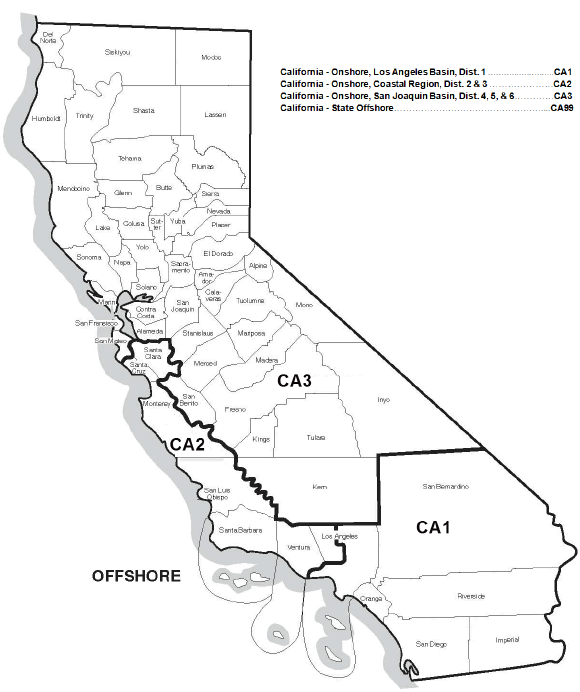
Source: U.S. Energy Information Administration, Office of Oil, Gas, and Coal Supply Statistics
Subdivisions of California
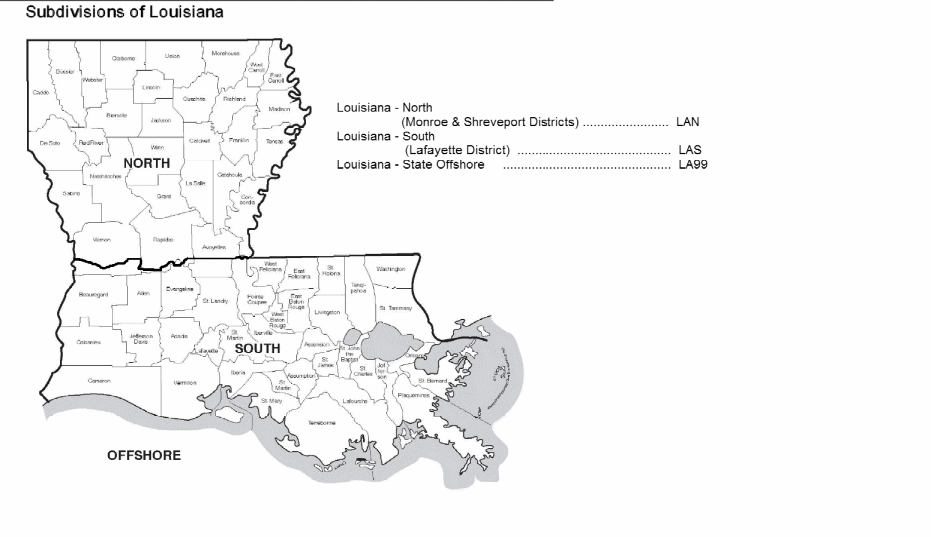
Source: U.S. Energy Information Administration, Office of Oil, Gas, and Coal Supply Statistics
Subdivisions of Louisiana
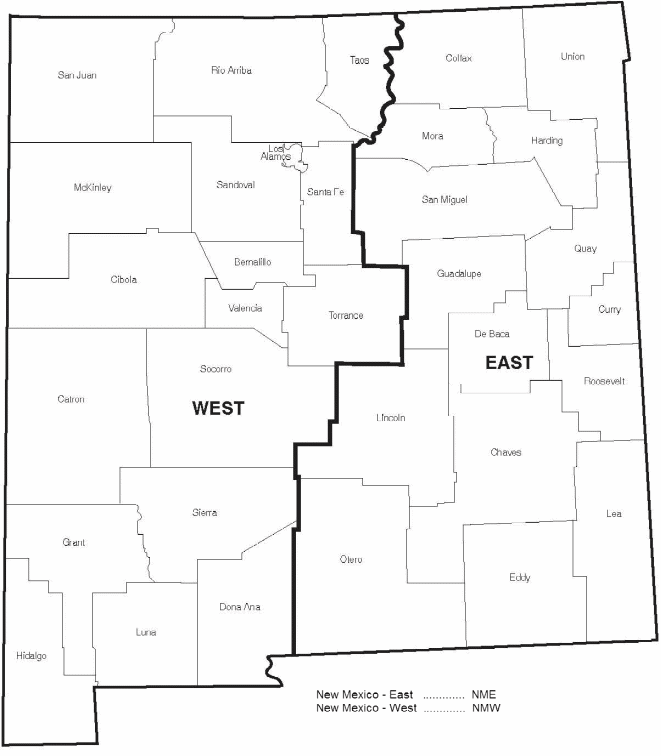
Source: U.S. Energy Information Administration, Office of Oil, Gas, and Coal Supply Statistics
Subdivisions of New Mexico
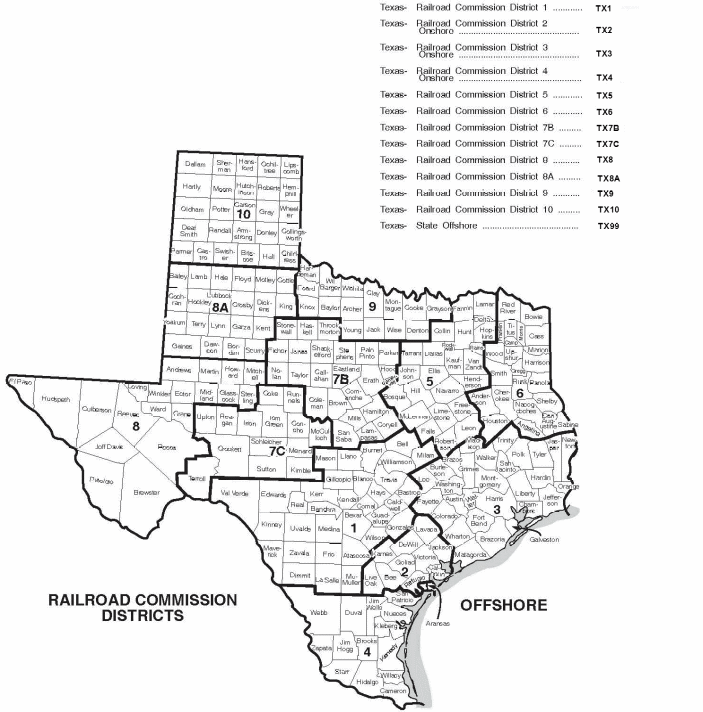
Subdivisions of Texas
Western Planning Area, Gulf of Mexico Outer Continental Shelf Region
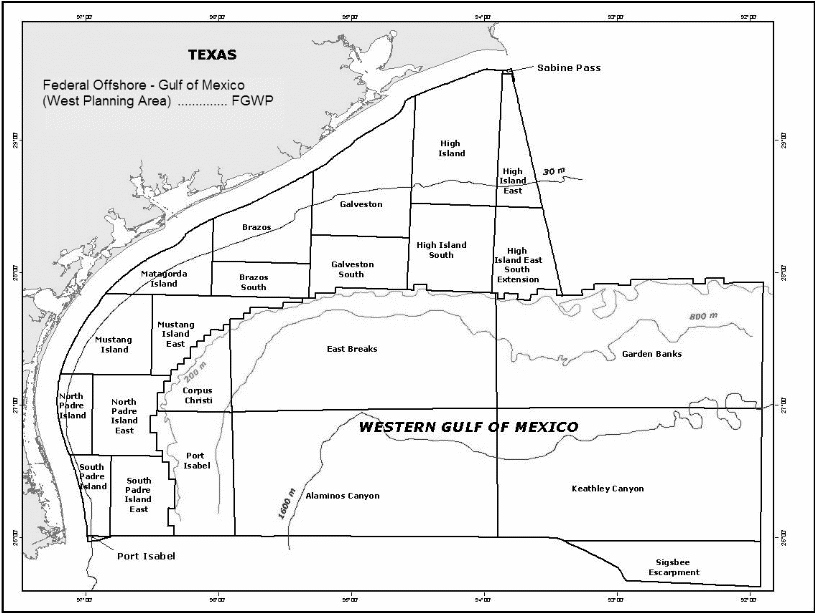
Source: U.S. Department of the Interior
Central Planning Area, Gulf of Mexico Outer Continental Shelf Region
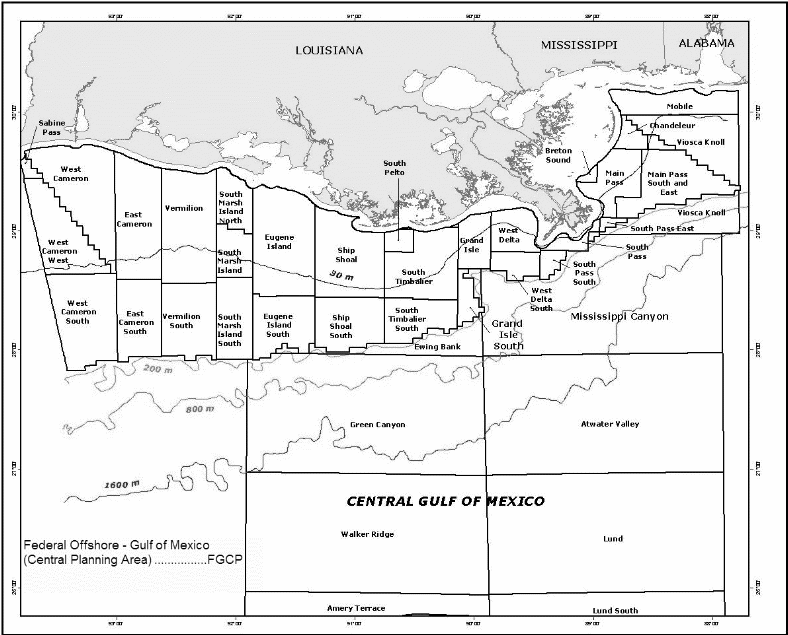
Source: U.S. Department of the Interior
Eastern Planning Area, Gulf of Mexico Outer Continental Shelf Region
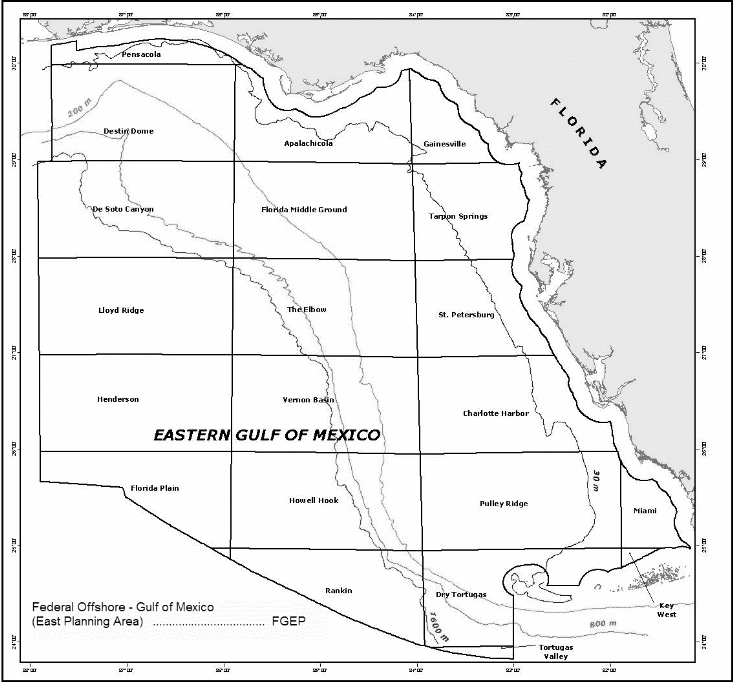
Source: U.S. Department of the Interior.
Energy Information Administration
Secure File Transfer System
Welcome to EIA’s Secure File Transfer System. Following are the instructions for sending your Excel and .Dat files to EIA by HTTPS.
Open your browser and type in the URL:
https://signon.eia.doe.gov/upload/noticeoog.jsp
The Secure File Transfer Notice to Users page will come up.
If you wish to continue, press the Accept button with your mouse. The Secure File Transfer page will come up.
You may navigate through the boxes on the page either with the tab key or with your mouse.
Type your name, company name, phone number and email address into the boxes provided. Note that the email address is required so that we can send you a confirmation of the receipt of your data.
In the yellow box, select the Browse button after File 1.
A dialog box will come up which will allow you to find the file on your hard drive or other mapped drives. Select the file with a double mouse click (or single mouse click on the file and mouse click on the Open button). The name will appear in the white box on the Secure File Transfer page. (Note that you can type in the full path of the file if you wish, but there is a greater chance of making a mistake.)
If you have other files that you want to transfer, repeat steps 6 and 7 up to four more times.
If you want to start over with the file selection, select the Reset button.
If you are ready to submit your files, select the Submit button. Please be patient; it may take a minute or two to upload your files. Do not close your browser during the upload. Wait to see the confirmation page.
A confirmation page will be displayed that will tell you the names of the files you have transferred, the confirmation number for each file, and the date and time of the transfer.
If you have more files to transfer, select the Back to Secure Upload button to return to the Secure File Transfer page. Your contact information will remain, but the file section will be empty.
Repeat steps 6-10.
When you are finished, close your browser by clicking on the X in the upper right corner.
If you have any trouble transferring your files, please call the EIA-23L Coordinator at 800-879-1470.
About Transferring Files Securely with HTTPS:
EIA is ensuring the security of your transactions by using the latest Internet security technology. The technology being used to protect your data is encryption which is the scrambling of data into a code that is unreadable to anyone who does not have the key that deciphers it. The secure hypertext transfer protocol (HTTPS) is a communications protocol designed to transfer this encrypted information between computers over the World Wide Web. All information is protected by 128-bit encryption to maintain the privacy and confidentiality of your data. The only thing you need to take advantage of strong encryption technology is a secure browser, one that supports 128-bit encryption.
201X EIA-64A Annual Report of the Origin of Natural Gas Liquids Production
| File Type | application/vnd.openxmlformats-officedocument.wordprocessingml.document |
| File Title | Energy Information Administration |
| Author | Paul Chapman |
| File Modified | 0000-00-00 |
| File Created | 2021-01-24 |
© 2025 OMB.report | Privacy Policy